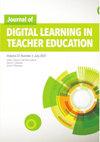准备初等教育教师候选人的教学技术:建模的作用
Q1 Social Sciences
Journal of Digital Learning in Teacher Education
Pub Date : 2020-07-31
DOI:10.1080/21532974.2020.1795953
引用次数: 10
摘要
摘要在教师教育项目中,来自学校教师和临床教育者的建模可以支持教师候选人采用新的教学实践。本研究探讨了师范教育教师和临床教育工作者的建模如何影响初等教育教师候选人的技术整合知识的发展和在教学中使用技术。进一步的分析着眼于技术建模和使用如何使用修订后的布鲁姆分类法框架(Anderson & Krathwohl, 2000)与高阶思维技能保持一致。教师教育教师主要通过高阶思维技能(如严格的实践活动和基于项目的学习)来模拟技术整合,而临床教育工作者则通过低阶活动(如教育复习游戏和展示视频)来模拟技术整合。此外,候选人以较低级别的方式使用技术比以较高级别的方式使用技术更多。基于本研究的结果,我们探讨了建模如何支持教师候选人的TPACK发展。本文章由计算机程序翻译,如有差异,请以英文原文为准。
Preparing elementary education teacher candidates to teach with technology: The role of modeling
Abstract In teacher education programs, modeling from both teacher education faculty and clinical educators in schools can support teacher candidates’ adoption of new instructional practices. This study examined how modeling from both teacher education faculty and clinical educators influenced elementary education teacher candidates’ development of technology integration knowledge and use of technology while teaching. Further analysis looked at how technology modeling and use aligned to higher-order thinking skills using the Revised Bloom’s Taxonomy framework (Anderson & Krathwohl, 2000). Teacher education faculty primarily modeled technology integration with higher-order thinking skills such as rigorous practice activities and project-based learning, whereas the clinical educators modeled technology integration through lower-level activities such as educational review games and showing videos. Further, candidates used technology in lower-level ways more than higher-level ways. Based on the findings of our study, we discuss how modeling can support teacher candidates’ development of TPACK.
求助全文
通过发布文献求助,成功后即可免费获取论文全文。
去求助
来源期刊

Journal of Digital Learning in Teacher Education
Social Sciences-Education
CiteScore
4.90
自引率
0.00%
发文量
15
 求助内容:
求助内容: 应助结果提醒方式:
应助结果提醒方式:


